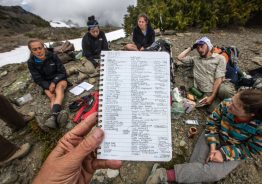What if every coastal community along the entire Pacific Rim were involved in monitoring their local marine environment, and all of that data were brought together in one place? Imagine, for example, if residents in Long Beach, Washington, could submit information about seabirds they observe, then look up bird data from another coastal community in southeast Alaska to compare notes. Think about the possibilities if new data were combined with traditional knowledge to bound climate impacts, or if local knowledge contributed to oceanography.
Read more at UW Today »10 UW Environment stories you may have missed over the summer
At the conclusion of a long and arduous academic year, many students look forward to the rest and relaxation that comes with summertime. But while many are enjoying the glorious downtime of a few months without classes, others — faculty, undergrads, graduate students and postdocs — are in the field and in labs pushing their research forward. The summer of 2016 was no different.
Read more »UW scientist helping direct NASA field study of clouds off Namibia
Tiny aerosol particles, emitted by everything from tailpipes to trees, float above us reflecting sunlight, seeding clouds and absorbing solar heat. How exactly this happens — and how it might change in the future — is one of the biggest uncertainties in how humans are influencing climate. University of Washington scientists are part of a NASA field campaign, Observations of Aerosols Above Clouds and their Interactions, or ORACLES, that is flying research planes around clouds off the coast of Namibia to see how smoke and clouds interact.
Read more at UW Today »Microbes help plants survive in severe drought
With California in its fifth year of severe drought and many western states experiencing another year of unusually dry conditions, plants are stressed. Agricultural crops, grasses and garden plants alike can get sick and die when factors such as drought and excess sun force them to work harder to survive. Now, plants can better tolerate drought and other stressors with the help of natural microbes, University of Washington research has found.
Read more at UW Today »All polar bears across the Arctic face shorter sea ice season
It’s no secret that Arctic sea ice is melting. Polar bears, the poster child for climate change, are among the animals most affected by the seasonal and year-to-year changes in Arctic sea ice, because they rely on this surface for essential activities such as hunting, traveling and breeding. A new University of Washington study, with funding and satellite data from NASA, finds a trend toward earlier sea ice melt in the spring and later ice growth in the fall across all 19 polar bear populations, which can negatively impact the feeding and breeding capabilities of the bears.
Read more at UW Today »





